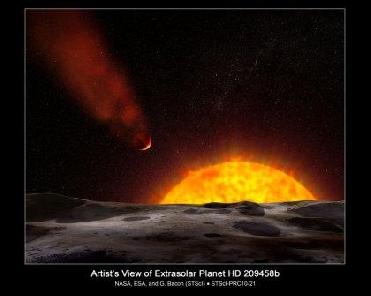
Artist's view of extrasolar planet HD 209458b. Photo by NASA, ESA, G. Bacon (STScI)
NEW DELHI (BNS): Astronomers have confirmed the existence of a baked object that could be called a ‘cometary planet.’ The gas giant planet, named HD 209458b, is orbiting so close to its star that its heated atmosphere is escaping into space.
Observations taken with Hubble's Cosmic Origins Spectrograph (COS) suggest powerful stellar winds are sweeping the cast-off atmospheric material behind the scorched planet and shaping it into a comet-like tail, according to a study published in the Astrophysical Journal.
The planet, located 153 light-years from Earth, weighs slightly less than Jupiter but orbits 100 times closer to its star than the Jovian giant. The roasted planet zips around its star in a short 3.5 days. In contrast, the solar system's fastest planet, Mercury, orbits the Sun in 88 days.
The extrasolar planet is one of the most intensely scrutinized, because it is the first of the few known alien worlds that can be seen passing in front of, or transiting, its star.
During a transit, astronomers study the structure and chemical makeup of a planet's atmosphere by sampling the starlight that passes through it. The dip in starlight because of the planet's passage, excluding the atmosphere, is very small, only about 1.5 percent. When the atmosphere is added, the dip jumps to 8 percent, indicating a bloated atmosphere.
COS detected the heavy elements carbon and silicon in the planet's super-hot, 2,000-degree-Fahrenheit atmosphere. This detection revealed the parent star is heating the entire atmosphere, dredging up the heavier elements and allowing them to escape the planet.
The COS data also showed the material leaving the planet was not all traveling at the same speed. "We found gas escaping at high velocities, with a large amount of this gas flowing toward us at 22,000 miles per hour," leader of the COS study, Jeffrey Linsky said.
"This large gas flow is likely gas swept up by the stellar wind to form the comet-like tail trailing the planet."
Although this extreme planet is being roasted by its star, it won't be destroyed anytime soon. "It will take about a trillion years for the planet to evaporate," he said.
 Previous Article
Previous Article Next Article
Next Article













The Indian Air Force, in its flight trials evaluation report submitted before the Defence Ministry l..
view articleAn insight into the Medium Multi-Role Combat Aircraft competition...
view articleSky enthusiasts can now spot the International Space Station (ISS) commanded by Indian-American astr..
view article